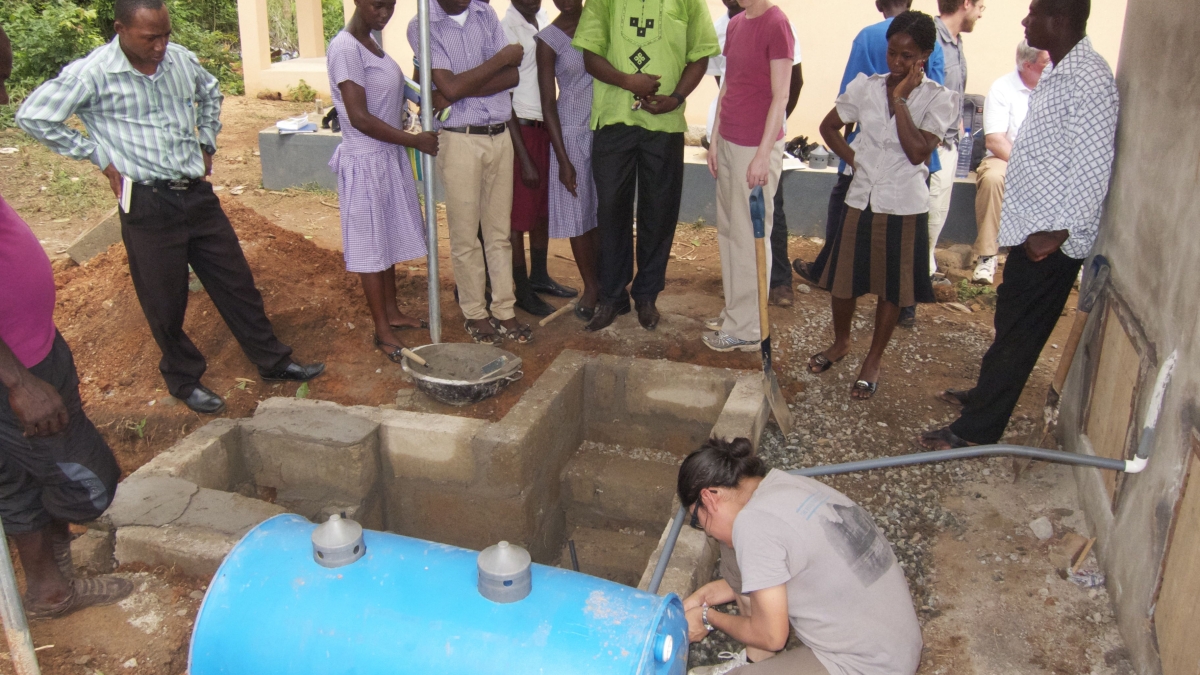ASU professors install sustainable latrine in Ghana

A team of faculty from ASU’s College of Technology and Innovation (CTI) traveled to Ghana in May to install an innovative pit latrine that purifies human waste and generates electricity.
Mark Henderson, professor in the engineering department at CTI, and Brad Rogers, associate professor in the department of engineering technology at CTI, are co-principal investigators on the project and collaborated with Caitlyn Butler, a civil engineering professor at the University of Massachusetts Amherst. Butler developed the primary design and implementation of the microbial fuel cell latrine while Henderson and Rogers supported the global sustainability efforts of the project. The project was funded by a $100,000 grant from the Grand Challenges Exploration program supported by the Bill & Melinda Gates Foundation.
Henderson and Rogers are the founders of GlobalResolve, a curriculum and program at CTI on the Polytechnic campus. GlobalResolve aims to develop sustainable technologies in energy, clean water, and local economic development for rural communities in the developing world. Because of their work in the organization and knowledge of various African communities, Henderson and Rogers were selected as co-principal investigators at the inception of the pit latrine project.
The pit latrine was developed as a response from many rural African communities who experience problems with waterborne diseases because of poor sanitation facilities. In the process, principal investigators designed a system in which liquids are used to generate electricity while solids can be used as compost for farming.
Henderson says the remaining materials not used to generate power or for compost are drained as grey water and have no effect on ground water or surrounding plant life.
Called a microbial fuel cell latrine, the system uses liquid parts to generate electricity by functioning as a fuel cell – urine is filtered from its solid counterparts and the nitrate in urine is oxidized in a chamber. During this process electrons are released through a cathode and produce electricity.
At this stage, with enough use the generated electricity lights the outhouse where the latrine is contained. Henderson and Rogers hope the system can be developed to produce even more electricity as technology improves and usage of the latrine becomes more frequent.
“Every GlobalResolve project we work on, we treat as a system,” Henderson said. “We have to look at all aspects of a project to ensure that sustainability will be improved while being sensitive to cultural needs.”
Henderson and Rogers travelled to Ghana twice to meet with the village chief in Agona Nyakrom – once to establish a relationship with local collaborators and again to actually build the device. Henderson says trust is paramount in developing connections with local authorities in unreached communities.
Collaborators traveled in May to the town, a Ghanaian village of about 20,000 residents. The latrine was installed on the grounds of a public high school which ensures the device will be used frequently and by both genders. It also serves as a learning lab for students in the community.
Locals of the town benefited economically from the latrine. Heavy digging was required to install the device that required manual laborers, trained masons and plumbers that were hired from Agona Nyakrom.
The latrine is undergoing a trial phase in which local community members will measure usage, take power readings, and assess cultural implications. Field-testing of the device will continue until May 2013. At that time, the device will be reassessed and, if successful, be implemented in other towns.
Rogers said the latrine project was designed and implemented the same way they teach students at CTI to execute their own global projects.
“Our project-based learning curriculum prepares students to think globally by giving them problems they might encounter in the real world,” he said. “The microbial fuel cell has a social and economic impact that will hopefully encourage sustainability within a community.”
Rogers will be presenting a research paper in October at the Fecal Sludge Management Conference in Durban, South Africa and share his experience in developing and installing microbial fuel cell technology.
Written by Sydney Donaldson, College of Technology and Innovation